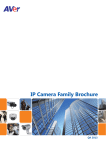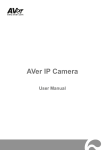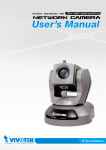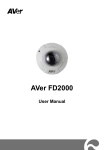Download AVer SF2121H-R User manual
Transcript
AVer SF2121H-R User Manual Table of Contents Important Safeguard ....................................................................... 1 Package Contents............................................................................ 2 Optional Accessory ......................................................................... 2 IP Camera Parts ............................................................................... 3 Front Panel ............................................................................................. 3 Rear Panel .............................................................................................. 3 CS-Mount Lens ....................................................................................... 3 Setting Up the IP Camera ................................................................ 4 Connecting the Lens ............................................................................... 4 Deploying Network .................................................................................. 4 Network Connection via Ethernet Switch .......................................... 4 Power over Ethernet Connection....................................................... 5 PoE Enabled Switch Connection Diagram ..................................... 5 PoE Injector Connection Diagram .................................................. 5 RJ45 LED ......................................................................................... 5 Connecting the External Devices to I/O Terminal Block .......................... 6 Adjusting the CS-mount Ring .................................................................. 6 Focusing the IP Camera with BNC Monitor .................................. 8 Setting up the IP Camera over the Internet................................... 9 Using DHCP Server/Router Network ...................................................... 9 Using NON-DHCP Server/Router Network ........................................... 10 Configuring the Internet Explorer Security Setting ................... 12 Using the IP Camera Browser Interface ...................................... 13 Preview ................................................................................................. 13 Using Media Player to view IP Camera ........................................ 15 System > General ................................................................................. 15 System > General > Maintenance......................................................... 15 To Upgrade the IP Camera Firmware .............................................. 16 System > General > Date & Time ......................................................... 17 System > General > System Log .......................................................... 18 System > User Management ................................................................ 18 System > User Management > Account................................................ 18 To Create a User Account ............................................................... 18 To Delete or Edit a User Account..................................................... 19 System > User Management > Connection .......................................... 20 To Add Filter .................................................................................... 20 System > Network ................................................................................. 21 System > Network > Setting ................................................................. 21 System > Network > Server .................................................................. 22 System > Network > DDNS .................................................................. 23 System > Network > QoS ..................................................................... 23 System > Network > Others .................................................................. 24 System > Image .................................................................................... 24 System > Image > OSD ........................................................................ 24 System > Image > Preference .............................................................. 25 System > Image > Exposure ................................................................. 26 System > Image > Advanced ................................................................ 27 System > Image > Privacy Mask........................................................... 28 System > Video Stream ........................................................................ 28 System > Audio ..................................................................................... 29 System > SD Card > Management ....................................................... 30 System > SD Card > FileSearch ........................................................... 31 Application > Motion Detection ............................................................. 31 To Set the Motion Detection ............................................................ 31 Application > Patrol ............................................................................... 32 To Setup the Patrol .......................................................................... 32 Event ..................................................................................................... 33 To Setup the Event .......................................................................... 34 Status Information ................................................................................. 35 Technical Specifications ............................................................... 35 Federal Communications Commission Statement (Class B) .... 37 Class B (EMC) ................................................................................ 38 COPYRIGHT ................................................................................... 38 NOTICE ........................................................................................... 38 WARNING ....................................................................................... 38 Limited Warranty ........................................................................... 38 Impor tant Safe guar d - Do not use power supply with different voltage than the one supplied in this unit. - Keep this unit away from direct heat or sunlight. - Unplug the power of this unit as soon as smoke or unusual odor is detected. - Do not expose this unit to rain or high humidity environment. - Do not attempt to open the housing or service this unit by yourself. Always refer all servicing to qualified service personnel. - Unplug the power supply before cleaning. Use only a lens cleaning cloth and never use benzine, thinner, or other solvent for cleaning. - Avoid placing this unit in a dusty - Do not place the unit in unsteady surface and also do not drop the unit. environment and avoid dust from entering the lens. 1 Packa ge Contents Make sure the following items are included in the package. Power Adapter (12V, 2A) * The power adapter will vary depending on the standard power outlet of the country where it is sold. AVer SF2121H-R 3 Lens Ring Pad Software & Manual CD Camera Stand L-type Hex Wrench 3 Screws 3 Plastic Anchor Optional Accessor y CS-mount Lens 2 IP Camer a Par ts F ro nt Pa ne l (3) (1) (1) (2) (3) Built-in MIC Lens Light Sensor (1) (2) (3) (4) (5) (6) (7) (8) (9) (10) (11) RJ45 Ethernet Port DC 12V I/O Terminal Block Power LED Indicator SD card slot Video Out Audio Out Reset button Console MIC DIP switch (2) (fig. 1.1) Rear Pa nel (6) (7) (1) (2) (8) (9) (10) (11) (3) (4) (5) (fig. 1.2) Note: The reset button will set all the configuration settings back to factory default. C S- Mou nt L en s (1) (2) (3) (fig. 1.3) 3 (1) (2) Zoom controller Focus controller (3) DC-Iris control cable Setting Up the IP Camera This section provides useful tips on how to adjust the IP camera to meet your needs. Co nn ect ing the Le ns 1. Screw in the CS-mount lens clockwise to the CS-mounting ring. Make sure the lens adhesive cover is removed when using it for the first time. 2. Connect the CS-mount lens cable to the socket. D e p lo yi n g N e tw ork Network Connection via Ethernet Switch 1. Connect the RJ45 cable from the Ethernet switch to LAN (PoE) port of SF2121H-R. Ethernet Switch 2. Connect the power adapter to DC12V port of SF2121H-R. Wall Outlet Power Adapter 4 Power over Ethernet Connection SF2121H-R is fully complied with PoE standard. It allows you to use PoE enabled switch or PoE injector to transmit data and power thru single Ethernet cable. PoE Enabled Switch Connection Diagram PoE Switch PoE Injector Connection Diagram PoE Injector Wall outlet Power cable Ethernet Switch RJ45 LED LED Blinking Green St e a d y Ye l l o w S ta t u s Connected to 100 Base-T mode and also transmitting and receiving data. Connected to the Internet. 5 Co nn ect ing the Exter na l D e vice s to I/O Te r min al B lo ck (1) (2) (3) (4) (5) (6) Alarm Data In Alarm Data Out Power 12V support 200mA Ground RS-485 (+) RS-485 (-) (1) (2) (6) (5) (3) (4) P ow er L ED LED St e a d y R e d Blinking Red No Light S ta t u s Power on Firmware update complete Power off I n ter na l Conne ct i o n Diag ram o f DI /DO Ad just ing t he C S- mou nt R ing 1. Unplug the CS-mount lens cable from the socket. 6 2. Unscrew the CS-mount lens counterclockwise. 3. Place one lens ring pad. 4. Screw the CS-mount lens and connect the CS-mount lens cable to the socket. Check if the IP camera can display proper image. If not, repeat step 3 and 4 to add the next ring. If all the rings are used up and still the IP camera cannot display proper image. Remove all the rings and continue to next step. 5. Using the L-type hex wrench loosen the bolt underneath the IP camera. 6. Remove the CS-mount ring from the IP camera. 7 7. Screw the CS-mount ring to the CSmount lens. 8. Screw the CS-mount lens clockwise back. Unscrew a little and plug the CSmount lens cable to the socket. Repeat this till the IP camera display the image properly. 9. Once the IP camera has detected the image, use the L-type hex wrench slightly secure bolt underneath the IP camera. Note: Do not fully tighten bolt underneath the IP camera for it may damage the CS-mount ring. Fo c u s i n g t h e I P C a m e r a w i t h B N C M o n i t o r The IP camera is supported with BNC analog video out port which allows you to connect an analog display devices such as an LCD BNC monitor for you to adjust the camera focus and zoom. 1. Connect the LCD BNC monitor to the Video Out port of IP camera using a BNC cable. VIDEO IN BNC PORT LCD BNC Monitor 8 2. Loosen up the focus and zoom control screws and adjust the focus and zoom range. Tighten the focus and zoom screw once you are done adjusting. Zoom Control Focus Control Setting up the IP Camer a over the Inter net Depending on your network connection, you can add the IP camera to the network in DHCP or Non-DHCP server/router. Make sure the IP address of your computer and the IP camera must be within the same LAN. In accessing the IP camera, you need to use IE browser. Using DHCP Server/Router Netw ork DHCP server/router network automatically assigns IP addresses to devices. You can use the IPCam Utility software in the CD to search the IP camera in the network. 1. Make sure the DIP switch behind the IP camera is set to DHCP. 2. Install the AVer IPCam Utility software. 3. Run the IPCam Utility. 4. Select the proper network adapter and click [Search] to begin searching. 5. Select and double click the IP camera you want to access. If you want to change the setting of the selected IP camera, enter the user ID, correct password, and change the 9 settings and then click [Apply]. This will change the setting and rescan the network again. 6. The IE browser will open and direct you to IP camera login page. This requires IPViewer.ocx to run. If the IE ActiveX warning message appears, click to allow running the add-on. Default ID : admin Password : admin Using N ON-DHC P Server/R outer Netw ork In Non-DHCP server/router network, the static IP address must be assigned to the device and each time when adding another IP camera in the network, the default IP address of the current one must be changed to avoid conflict. Default IP : http://192.168.1.168 1. Make sure the DIP switch behind the IP camera is set to Static IP. 2. Connect the computer to the network and set the IP address with the same subnet prefix of 192.168.1.XXX. The last decimal number should be set any from 1 to 255 except 168 and other IP addresses that are already being assigned. Then set the Subnet Mask to 255.255.255.0. To change the computer IP address, go to Control 10 Panel > Network Connections > right click on the connection to change > option to TCP/IP or TCP/IPv4 Properties. 3. Type the default IP http://192.168.1.168 in the IE address bar. 4. You will be directed to IP camera login page. This requires IPViewer.ocx to run. If the IE ActiveX warning message appears, click to allow running the add-on. Please refer to p.12 on how to configure the Internet Explorer security setting. Default ID : admin Password : admin 5. In adding another IP camera in the network, the default IP address of the current IP camera must be changed to avoid conflict. To change the default IP address, in IP camera browser interface, click System > Network > Setting > Network Type > Static. Then in the IP address change the last decimal number 192.168.1.168 to any unassigned number in the network and click Save. The page will turn dark while saving. 6. To view the newly assigned IP, just enter the new IP address in the IE address bar and you will be directed to the login page. To add another IP camera, repeat all these steps except step 2. 11 Configuring the Inter net Explorer Security Setting ActiveX is required to view and access the IP camera. High Internet Explorer security setting may prevent you from installing the ActiveX. If you are unable to view the IP camera, you may need to install ActiveX or change the security setting. To ch an ge t he In ter ne t Exp lorer Secu r it y Set ting 1. Run Internet Explorer. 2. Click Tools > Internet options. 3. Click Security tab > Local Internet > Custom level. 12 4. Go to ActiveX control and plug-ins and change all Disable setting to Enable or Prompt. Then click [OK]. You will now be prompt to install ActiveX and view the IP camera. U si n g th e I P C a m e r a B r ow s er I n t er fa c e The admin have the full access to the IP camera browser interface. The menu on the left, you can expand and navigate to access all the features. P r e vi ew In the Preview page, all three user levels can view and change the language setting, the IP camera video stream setting, use the digital or RS-485 Pan and Partol control, capture screen shot, record video, turn on/off 2-way talk, mic and volume, and adjust the zoom and volume level. (3) (2) (1) (4) (5) (6) (7) (8) (9) (10)(11)(12)(13) (14) 13 Name (1) Language (2) Video screen Function Select the browser interface language. Change the video screen display. Display the actual video pixel size. Display the video screen in compact size. (3) Stream (4) Direction buttons (5) Pan & Patrol button (6) Digital /RS485 (7) Speed Control (8) Zoom control Display the video on the entire screen. Press ESC to exit full screen mode. Switch to view the video stream type. The IP camera can send multiple video streams of up to 3 types. To change the video stream setting, go to System > Video Stream. - Use to move the position of the view point while in zoom mode. - Use to control the position of the RS-485 pan tilt device Pan - automatically move the view point from left to right when in zoom in mode. Patrol - automatically move the view point around the preset locations in Application > Patrol. - Select Digital to control the IP camera ePTZ operation. This allows you to closely view the target area without having to physically move the IP camera. The image will be zoomed in and you can use the direction control to pan the zoomed image. - Select RS-485 to control the PTZ driver or scanner via RS-485 connection to I/O terminal block. The IP camera is mounted on an RS-485 pan tilt device. Set the speed when panning, tilting, or zooming. Reset zoom level. Increase zoom level. Decrease zoom level. (9) Capture (10) Record (11) 2-way talk (12) Mic (13) Sound (14) Volume bar Capture and save the image on the screen in *.bmp format. Start/stop audio and video recording. The recorded video will be saved in *.mp4 format. Enable/disable mic from IP camera browser side. Enable/disable mic from the IP camera side. Enable/disable audio from the IP camera side. Adjust the volume. 14 Using Media Player to view IP Camer a Some media player support viewing network streaming such as VLC media player. Use the format below to view your IP camera. The WWW.XXX.YYY.ZZZ below represents the IP address. RTSP://WWW.XXX.YYY.ZZZ:554/live_st1 -->for Stream 1 RTSP://WWW.XXX.YYY.ZZZ:554/live_st2 -->for Stream 2 (if stream 2 is enable) RTSP://WWW.XXX.YYY.ZZZ:554/live_st3 -->for Stream 3 (if stream 3 is enable) S ys t e m > G ene ra l In this section, only admin level is authorized to configure the IP camera general settings. There are 3 tabs in General settings: Maintenance, Date & Time, and System Log. You can view the significant occurrence in the IP camera such as S ys t e m > G ene ra l > M a int en anc e In the Maintenance tab, the admin can easily backup and restore the IP camera setting, reboot the IP camera, reset all the settings to factory default, and upgrade the IP camera firmware. (1) (2) (3) (4) (5) (6) 15 (1) (2) (3) (4) Name Export Settings Import Settings Reboot Reset (5) Factory Default (6) Firmware Upgrade Function Backup all the configuration settings. Restore or replace the current settings with the backup file. Restart the IP camera. Set all the configuration settings back to default except the user management and network settings. Set all the configuration settings back to factory default. Upgrade the firmware to the latest version. To Upgrade the IP Camera Firmware 1. Download the file from our website and save it in your computer hard disk. 2. Click Browse. Locate and select the file and click Open. 3. Click Apply. Wait till you see the massage “Firmware Upgrade OK!!”. You may now click the IE browser refresh button or press F5. The login page will appear. 16 S ys t e m > G ene ra l > D a t e & Tim e In the Date & Time tab, admin can manually set the date and time setting or synchronize it with the Internet time server or the computer date and time setting. This is used to record the time whenever there is a significant occurrence listed in system log and is also used in event scheduling. After completing the setting, click Save to apply the new setting and Cancel to keep the old setting. (1) (2) (3) (4) (1) (2) (3) (4) Name Current Date & Time Date Format Time Zone Setting Method Function Display the current date and time setting. Select the date display format. Set the local time zone. Select the date & time setting method. Sync with current PC – obtain the date and time setting on the current login computer. Sync with NTP Server – obtain the date and time setting from NTP server. In the drop-down list, select the NTP host name. Manual – manually set the date and time. Click Now to set the date base on the computer time setting and Done to close the date and time interface. 17 S ys t e m > G ene ra l > S ys t e m L og In the System Log, admin can view and search the significant event occurred in the IP camera. S ys t e m > U s er Ma nag e men t In User Management, only admin level is authorized to create, delete, and edit account to connect to the IP camera and configure the client connection setting. There are 2 tabs in User Management setting: Account and Connection. S ys t e m > Us er Ma nag e men t > Ac co unt In Account tab, admin can create, delete and set the access level of the user account. To Create a User Account 1. Click System > Users Management > Account tab. 2. Enter the User Name, select the User Type, enter the User Info and click Create. 18 User Type Access rights Admin Can access all the configuration pages Operator Can preview live image, modify and adjust certain settings except in System > General, User Management, and Network; and SD Card > Management. As for the I/O Control, admin could enable/disable allowing operator to access it. Viewer Can only access the preview and status information pages. 3. Enter the same password in Password and Confirm Password text box. Then click Add. To Delete or Edit a User Account Select the user account you want to delete or edit in User Management > Account tab. - Click Cancel to void the operation. - Click Modify to apply the new changes. Make sure to edit the account before clicking the Modify button. - Click Remove to delete the account. 19 S ys t e m > Us er Ma nag e men t > Co nn ect ion In Connection tab, admin can set the total number of user to access the IP camera, and filter the IP address to allow or deny accessing the IP camera. (1) (2) (3) (4) (5) Name (1) Http Connection (2) Maximum Number of Clients (3) Enable Filter list (4) Filter Type (5) Filter List Function Select the connection type. For higher security data transmission level, select http & https or https only. This authenticate and encrypted the data over the SSL(Secure Socket Layer). Select the max number of user to simultaneously access the IP camera. Select to turn the IP address filtering on/off. Select to allow/deny the IP address in the filter list to access the IP camera. Create and display the filtered IP address. To Add Filter 1. Click Add Filter in User Management > Connection tab. 2. In Rule drop down list, select from the 3 types of rules: Single, Network and Range. Single – add an IP address Network – assign a network address and the 20 Name Function corresponding subnet mask to be filtered. Range – assign a range of IP address to be filtered. 3. Save to add the created data in the filter list or Cancel to void the operation and exit. S ys t e m > N e tw ork In this section, only admin level is authorized to set up the Network settings. S ys t e m > Ne tw ork > Set ting In Setting tab, you can configure the type of network connection for IP camera and assign name for the IP camera. Depending on the network connection, IP camera can be accessed from the computer within the same local area network (LAN) or anywhere with Internet connection. After completing the setting, click Save to apply the new setting and Cancel to keep the old setting. (1) (2) (3) Name (1) Device Name (2) Network HW Switch Function Assign name for the IP camera. Enable/disable to use the IP camera dip switch network setting. If this is enabled, make sure the dip switch behind the IP camera is set properly. 21 Name (3) Network Type Function Select the type of IP camera Network connection. DHCP – select this option to automatically obtain an IP address from the DHCP server, whenever the IP camera is connected to the network. You can use the IP camera UPnP Discovery software in the CD to easily setup the IP camera network. Static IP – select this option to manually assign a fix IP address to the IP camera. PPPoE – select this option to access the IP camera anywhere with Internet connection. To use this option, this requires an account provided by the ISP. Set this setting while connected to the LAN and click save. Connect the IP camera directly to DSL or cable modem. S ys t e m > N e tw ork > S e r ve r In Server tab, you can configure the Email, FTP, and NAS setting. It is necessary to configure the server settings so that IP camera can perform the task in the Event setting when a trigger is activated. You can configure either one or all of it. After completing the setting, click Save to apply the new setting and Cancel to keep the old setting. 22 S yst em > Netw ork > DDN S In DDNS tab, you can configure the dynamic domain name service setting. DDNS is a service that provides fixed host and domain name for the IP camera with dynamic IP address. It automatically updates the new IP address to the dynamic server of the domain name. To use this feature, you need to register a domain name at http://dyn.com/dns/ . Enter the DDNS domain name, user, password and enable DDNS enable check box. After completing the setting, click Save to apply the new setting and Cancel to keep the old setting. S ys t e m > N e tw ork > Q o S In Qos tab, you can configure the Quality of Service setting. Enabling the QoS allows you to set the parameter and prioritize the IP camera to provide stable streaming performance at a certain level in a traffic network. 23 S ys t e m > N e tw ork > Ot he rs In Others tab, you can configure the enable/disable the UPnP setting. If your router does not support UPnP function, you can enable the UPnP forwarding and set the port mapping. S ys t e m > Ima ge Both admin and operator levels can adjust the Image setting. There are 5 tabs: OSD, Preference, Exposure, Advanced, and Privacy Mask. S ys t e m > Ima ge > O SD In OSD tab, you can enable/disable overlaying time stamp, text title and add logo. After completing the setting, click Save to apply the new setting and Cancel to keep the old setting. (1) (2) (3) (4) (5) 24 Name (1) Time Stamp (2) Title Stamp (3) Title Text (4) Logo (5) Customize Logo Function Select the location of the Time Stamp. Click the checkbox to enable/disable display the date and time stamp. Select the location of the Text Title. Click the checkbox to enable/disable display the text title. Enter the title text, e.g. 10F. Select the location of the logo image file. Click the checkbox to enable/disable display the logo. Upload your company logo. The maximum size is 64 x 64 pixels. S ys t e m > Ima ge > Pre f er en ce In Preference tab, you can tune the IP camera white balance, display color or black & white, set the flicker frequency, change the video orientation, and adjust the brightness and contrast. After completing the setting, click Save to apply the new setting and Cancel to keep the old setting. 25 S ys t e m > Ima ge > Exp os ur e In Exposure tab, you can set the exposure zone, exposure mode, and calibrate the DC Iris. After completing the setting, click Save to apply the new setting and Cancel to keep the old setting. (1) (2) (3) Name (1) Exposure Area (2) Exposure Mode (3) DC-Iris Calibration Function Select the exposure area choices to define the light distribution and bring out more details. Entire screen - measure the entire screen to adjust the exposure. Customize - measure the exposure to where the adjustable and movable frame on the screen is located. Move the spot to dark zone to adjust the light condition. Backlight compensation - measure the exposure at the center of the screen. Select to automatically or manually adjust the exposure. For manual exposure control, adjust the exposure level control to the best image quality. Click Start to automatically adjust the DC Iris lens and do this under a sufficient or brighter light room condition. Perform this operation only when the video image appears to be like hunting. This is when the iris is unable to stabilize the image. 26 S ys t e m > Ima ge > A dva n c ed In Advanced tab, you can configure the Wide Dynamic Range, Denoise, IR-Cut Filter, and B/W image at night. After completing the setting, click Save to apply the new setting and Cancel to keep the old setting. (1) (2) (3) (4) (5) Name (1) Wide Dynamic Range (2) Denoise (3) IR-cut Filter Function WDR effectively balances the video image on the screen in both bright and dark areas making it possible to see clear details. You can choose from 3 levels depending on your choice or disable WDR. Select enable/disable to reduce the excessive noise on the video image. The IR cut filter is a mechanism that prevents the infrared light from hitting the sensor. During day time the IR light has an interfering effect on the image quality of the camera, which leads to corruption of color and contrast as well as blurring. At night time, the infrared light is used to achieve more detailed images in the dark or with low ambient light. Auto – automatically switch on/off the IR cut filter. It uses the light sensor in front of the camera to determine the level of ambient light. Day Mode – switch on the IR cut filter at all time to prevent the IR light from hitting the sensor so that the color will not be corrupted. Night Mode – switch off the IR cut filter at all time to let the sensor receives the IR light which could help improve low light sensitivity. Schedule – specify the time on when to switch off the IR cut filter to night mode. The time format is hh:mm and in 24-hour clock time. 27 Name (4) B/W image at night (5) Night mode priority Function Select to enable/disable switching to B/W during night mode. Select the one you want to prioritize during night mode image quality or frame rate. S ys t e m > Ima ge > Pr iva c y M a s k In Privacy Mask tab, you can enable 3 privacy masks. Simply adjust the size and position the mask on the area you want to conceal. The viewer will not be able to see the masked area. It will cover the video screen with black frame. S ys t e m > Vid eo St rea m Both admin and operator levels can configure the Video Stream. After configuring the video stream setting, click Save to apply the new setting and Cancel to keep the old setting. (1) (2) (3) (4) 28 Name (1) Stream Type (2) Codec Type (3) Resolution (4) Stream Function Select to transmit single or simultaneous multiple streams of 2 or 3 videos. Select the type of video compression codec. Select the video size. On each stream, set the frame rate, bitrate and rate control setting. VBR (Variable Bit Rate) by default use this setting if there is a need to maintain the image quality whenever there is lot of activities on the scene or no motion. This setting keeps the video stream constant as possible which increases the bandwidth requirement when there is high motion and decreases when there is no motion. The bandwidth must be able to accommodate high throughputs. CBR (Constant Bit Rate) use this setting if there is bandwidth concern. This setting is restricted to keep the bit rate setting. This could affect the image quality and frame rate if there is high activity that result in a bit rate that is higher than the set bit rate. S ys t e m > A u d io Both admin and operator levels can configure the IP camera audio setting. After configuring the Audio setting, click Save to apply the new setting and Cancel to keep the old setting. (1) (2) (3) (4) 29 Name (1) Audio (2) Internal/External MIC gain (3) Audio Codec (4) Alarm Audio Function Select to enable/disable the IP camera built-in mic and mic port. Select to boost up the internal/external mic gain or set to normal. Select the audio protocol, algorithm, and audio bit rate. G.711 – uses Pulse code modulation (PCM) of voice frequencies on a 64 kbps channel. G.726 – uses 40, 32, 24, 16 kbit/s adaptive differential pulse code modulation (ADPCM) Select to choose from 2 types of alarms sound or customer alarm to use the uploaded alarm sound. The supported sound format are in *.wav (PCM 8KHz/16bit Mono, 10 seconds). S ys t e m > S D C a rd > M an age m en t Both admin and operator levels can manage the SD Card local storage. After managing the SD Card setting, click Save to apply the new setting and Cancel to keep the old setting. We recommend formatting the SD card when using it for the first time. (1) (2) (3) (4) (5) Name (1) SD Card Info (4) Delete data after Function Shows the SD card details. No details will appear if SD Card is not inserted. Enable/disable cycle recording. The old file in the SD card will be overwritten with the latest one when it has reached the maximum capacity. Enable/disable automatic clear the data in SD card. The file will be deleted when it reached the number of days set in Delete data after [xx] days. Enter the number of days you wish to retain a file. (5) Format Click Format to delete all the data in the SD card. (2) Cycle Storage (3) Automatic Cleanup 30 S ys t e m > S D C a rd > F i l e Sea rc h Use this to search the captured image in the SD card. Ap p lic at ion > Mo tion De tect ion Both admin and operator levels can specify up to 3 areas on the screen to monitor the motion. In the motion detection page, the frame will blink when the motion detected has reached the percentage threshold setting. This feature can be utilized to trigger a response in Event setting. To Set the Motion Detection 1. 2. 3. 4. Click Application > Motion Detection. Enable the region check box to create a motion detection frame. Move and adjust the frame to the area you want to detect the motion. Adjust the sensitivity and percentage. Sensitivity detects the motion on the screen and 31 assesses the changes in pixel thru percentage. The motion detection will activate when the Monitor level reaches the defined percentage. 5. Click Save to apply the new setting and Cancel to keep the old setting. A p p l ic at ion > P at r o l Both admin and operator levels can customize the Patrol setting. In this section, you can set the patrol target area, patrol sequence and dwelling time. To Setup the Patrol 1. Click Application > Patrol. 2. Use the direction buttons and zoom button to locate the patrol target area. Press view the full image and reset the zoom level. to 3. Type a name for the patrol shooting area e.g. UpperLeft in the Name text box and press [Add]. The preset target area will be listed in the User Preset Locations. Click to to show the preset target area. Repeat step 2 and delete the preset target area and 3 to add more preset locations. to create the patrol sequence. The 4. Select the preset target area in the list and press selected present target area will be listed in the Patrol Locations. 32 5. Set the dwelling time for how long you want to stay in the preset target area. Doubleclick and enter the time. Then click OK or press enter to apply the changes. 6. Click to delete the selected preset location in the Portal Locations list and arrange the patrol order. 7. Click Save to implement the preset patrol setting. to Event Both admin and operator levels can configure the Event setting. In this section, the IP camera can be configured to perform an action when an event is triggered at the specified time. 33 To Setup the Event 1. Click Event. 2. On the time table, click-drag to select from what time to what time to specify the period of the event. 3. Type a name for the Event setting. One word only and no special character. 4. Select the event color setting. 5. Set the schedule. You can edit the time and choose the days to apply the same time setting. 6. Enable the type of selection for the IP camera to trigger. - Periodically Every Other This triggers the IP camera every other minute based on the set time. - Motion Detection Region 1/2/3 This triggers the IP camera when a motion is detected on the motion detection region. - Digital Input This triggers the IP camera when the external digital input device or sensor is activated. - SD-Card This triggers the IP camera when the SD card is not detected. - Network This triggers the IP camera when the Internet connection got disconnected. 7. Select the type of response for the IP camera to perform when a trigger is activated. Set the duration. Choose digital output to send recorded video or still image, or Alarm Audio to sound the alarm. Then select the type of server/media to where to send the file. To configure the Mail, FTP, and NAS setting, go to System > Network > Server tab. 34 Snapshot and System log support sending the file thru Mail, and storing in FTP, NAS or SD card. You can enable multiple options to send and save the captured image. Video Clip supports storing in FTP, NAS or SD card. You can only select one storage option to save the video file. For better performance, we recommend setting the video stream bitrate value in System > Video Stream > Stream 1/2/3 > bitrate to 4000 kbps. 8. Click OK to add the event setting, Delete to remove, and Cancel to void and close the event setting. Statu s Info r mat ion Show the information about the device and network setting. Te c h n i c a l S p e c i f i c a t i o n s Device Type Box Compatibility ONVIF Application environment Indoor/Outdoor Indoor / outdoor with suitable housing System Flash (MB) 128 RAM (MB) 256 Embedded OS Linux Camera Image Sensor 1/2.7" CMOS (2 megapixel Full HD) Min. illumination 0.2 Lux@F/1.2 Built-In ICR switchable 35 Auto Iris DC Iris Viewing angle Horizontal 42.2°~105.4° Vertical 23.8°~57.9° Diagonal 48.3°~123.1° Lens (Optional*) Lens type Vari-focal lens (CS mount) F/no F/1.2 Focal Length F=3.1~8mm Viewing angle 105.4°(W)~42.2°(T) 3-axis bracket adjustment angle N/A Video Compression H.264/MPEG-4/MJPEG Max. resolution H.264 1920 x 1080 MPEG-4 1920 x 1080 MJPEG 1600 x 1200 Max. frame rate H.264/MPEG-4 up to 30fps (1920 x 1080) MJPEG up to 24fps (1600 x 1200) MJPEG up to 30fps (1280 x 1024) H.264/MPEG-4 64Kbps~12Mbps MJPEG: 1(Low)~98(High) Bit rate mode Streaming H.264/MPEG-4/MJPEG Multi streaming, 3 streaming simultaneously IMD (Intelligent Motion Detection) zone 3 Privacy mask area 3 image orientation mirror, flip BLC (backlight compensation) supported WDR (wide dynamic range) supported De-noise supported Day & night function supported ePTZ supported Audio Audio encoder G.711/G.726 audio compression Audio Streaming 2-way audio Microphone Built-in microphone Network Protocols TCP/IP (IPv4), HTTP, HTTPS, UPnP, SMTP, FTP, DHCP, NTP, DDNS, PPPoE, 3GPP, Samba, QoS 36 Ethernet Ethernet (10/100 Base-T), RJ45 connector Security Password protection Users up to 10 users simultaneously Alarm Alarm Triggers Mail, FTP, SD-card, Terminal block (DI/DO), Samba Interface Digital input/output 1/1 Built-in storage option SD card slot External microphone input supported External Audio output supported RS-485 supported General Power supply DC 12V Max. power consumption PoE 4.5W(TYP.) PoE Class 3 (IEEE802.3af); power consumption: 6.5W(TYP.) Dimensions 69.00 W x 58.60 H x 165.05 D (mm) Net weight 490g (w/o bracket) Temperature and humidity 0°C~50°C, 20%~90% Software OS Windows XP/Vista/7 browser IE8.0 and above Firmware remote upgrade supported (via web browser) Bundled software supported up to 32CH Warranty Main body 2 years Accessories 1 year Fe d e r a l C o m m u n i c at i o n s C o m m i s s i o n S t at e m e n t (C l a s s B ) This device complies with Part 15 of the FCC Rules. Operation is subject to the following two conditions: (1) this device may not cause harmful interference, and (2 ) this device must accept any interference received, including interference that may cause undesired operation. NOTE- This equipment has been tested and found to comply with the limits for a Class B digital device, pursuant to Part 15 of the FCC Rules. These limits are designed to provide reasonable protection against harmful interference in a residential installation. This equipment generates uses and can radiate radio frequency energy and, if not installed and used in accordance with the instructions, may cause harmful interference to radio communications. However, there is no guarantee that interference will not occur in a particular installation. If this equipment does cause harmful interference to radio or television reception, which can be determined by tuning the 37 equipment off and on, the user is encouraged to try to correct the interference by one or more of the following measures: Reorient or relocate the receiving antenna. Increase the separation between the equipment and receiver. Connect the equipment into an outlet on a circuit different from that to which the receiver is connected. Consult the dealer or an experienced radio/television technician for help. Class B (EMC) This product is herewith confirmed to comply with the requirements set out in the Council Directives on the Approximation of the laws of the Member States relating to Electromagnetic Compatibility Directive 2004/108/EC. COPYRIGHT © 2012 AVer Information Inc. All rights reserved. All rights of this object belong to AVer Information Inc. Reproduced or transmitted in any form, or by any means without the prior written permission of AVer Information Inc. is prohibited. AVer Information Inc. reserves the rights to modify its products, including their specifications and any other information stated herein without notice. The official printout of any information shall prevail should there be any discrepancy between the information contained herein and the inform ation contained in th at printout. “AVer” is a trademark owned by AVer Information Inc. Other trademarks used herein for description purpose only belong to each of their companies. N OTIC E SPECIFICATIONS ARE SUBJECT TO CHANGE WITHOUT PRIOR NOTICE. THE INFORMATION CONTAINED HEREIN IS TO BE CONSIDERED FOR REFERENCE ONLY. WARNING TO RE DUCE RISK OF FIRE OR ELECTRIC SHOCK, DO NOT EXPOSE THIS APPLIANCE TO RAIN OR MOISTURE. WARRANTY VOID FOR ANY UNAUTHORIZED PRODUCT MODI FICATI ON. THE MARK OF CROSSED-OUT WHEELED BIN INDICATES THAT THIS PRODUCT MUST NOT BE DISPOSED OF WITH YOUR OTHER HOUSEHOLD WASTE. INSTEAD, YOU NEED TO DISPOSE OF THE WASTE EQUIPMENT BY HANDING IT OVER TO A DESIGNATED COLLECTION POINT FOR THE RECYCLING OF WASTE ELECTRICAL AND ELECTRONIC EQUIPMENT. FOR MORE INFORMATION ABOUT WHERE TO DROP OFF YOUR WASTE EQUIPMENT FOR RECYCLING, PLEASE CONTACT YOUR HOUSEHOLD WASTE DISPOSAL SERVICE OR THE SHOP WHERE YOU PURCHASED THE PRODUCT. Li mit ed War r anty For a period of time beginning on the date of purchase of the applicable product and extending as set forth in the “Warranty Period of AVer Product Purchased” section of the warranty card, AVer Information, Inc. (“AVer”) warrants that the applicable product (“Product”) substantially conforms to AVer’s documentation for the product and that its manufacture and components are free of defects in material and workmanship under normal use. “You” as used in this agreement means you individually or the business entity on whose behalf you use or install the product, as applicable. This limited 38 warranty extends only to You as the original purchaser. Except for the foregoing, the Product is provided “AS IS.” In no event does AVer warrant that You will be able to operate the Product without problems or interruptions, or that the Product is suitable for your purposes. Your exclusive remedy and the entire liability of AVer under this paragraph shall be, at AVer’s option, the repair or replacement of the Product with the same or a comparable product. This warranty does not apply to (a) any Product on which the serial number has been defaced, modified, or removed, or (b) cartons, cases, batteries, cabinets, tapes, or accessories used with this product. This warranty does not apply to any Product that has suffered damage, deterioration or malfunction due to (a) accident, abuse, misuse, neglect, fire, water, lightning, or other acts of nature, commercial or industrial use, unauthorized product modification or failure to follow instructions included with the Product, (b) misapplication of service by someone other than the manufacturer’s representative, (c) any shipment damages (such claims must be made with the carrier), or (d) any other causes that do not relate to a Product defect. The Warranty Period of any repaired or replaced Product shall be the longer of (a) the original Warranty Period or (b) thirty (30) days from the date of delivery of the repaired or replaced product. Limitations of Warranty AVer makes no warranties to any third party. You are responsible for all claims, damages, settlements, expenses, and attorneys’ fees with respect to claims made against You as a result of Your use or misuse of the Product. This warranty applies only if the Product is installed, operated, maintained, and used in accordance with AVer specifications. Specifically, the warranties do not extend to any failure caused by (i) accident, unusual physical, electrical, or electromagnetic stress, neglect or misuse, (ii) fluctuations in electrical power beyond AVer specifications, (iii) use of the Product with any accessories or options not furnished by AVer or its authorized agents, or (iv) installation, alteration, or repair of the Product by anyone other than AVer or its authorized agents. Disclaimer of Warranty EXCEPT AS EXPRESSLY PROVIDED OTHERWISE HEREIN AND TO THE MAXIMUM EXTENT PERMITTED BY APPLICABLE LAW, AVER DISCLAIMS ALL OTHER WARRANTIES WITH RESPECT TO THE PRODUCT, WHETHER EXPRESS, IMPLIED, STATUTORY OR OTHERWISE, INCLUDING WITHOUT LIMITATION, SATISFACTORY QUALITY, COURSE OF DEALING, TRADE USAGE OR PRACTICE OR THE IMPLIED WARRANTIES OF MERCHANTABILITY, FITNESS FOR A PARTICULAR PURPOSE OR NONINFRINGEMENT OF THIRD PARTY RIGHTS. Limitation of Liability IN NO EVENT SHALL AVER BE LIABLE FOR INDIRECT, INCIDENTAL, SPECIAL, EXEMPLARY, PUNITIVE, OR CONSEQUENTIAL DAMAGES OF ANY NATURE INCLUDING, BUT NOT LIMITED TO, LOSS OF PROFITS, DATA, REVENUE, PRODUCTION, OR USE, BUSINESS INTERRUPTION, OR PROCUREMENT OF SUBSTITUTE GOODS OR SERVICES ARISING OUT OF OR IN CONNECTION WITH THIS LIMITED WARRANTY, OR THE USE OR PERFORMANCE OF ANY PRODUCT, WHETHER BASED ON CONTRACT OR TORT, INCLUDING NEGLIGENCE, OR ANY OTHER LEGAL THEORY, EVEN IF AVER HAS ADVISED OF THE POSSIBILITY OF SUCH DAMAGES. AVER’S TOTAL, AGGREGATE LIABILITY FOR DAMAGES OF ANY NATURE, REGARDLESS OF FORM OF ACTION, SHALL IN NO EVENT EXCEED THE AMOUNT PAID BY YOU TO AVER FOR THE SPECIFIC PRODUCT UPON WHICH LIABILITY IS BASED. Governing Law and Your Rights This warranty gives you specific legal rights; You may also have other rights granted under state law. These rights vary from state to state. 39




















































